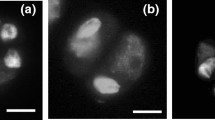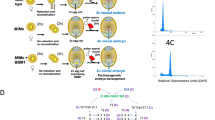Abstract
Apomixis in daisy fleabanes (Erigeron annuus and E. strigosus) is controlled by two genetically unlinked loci that regulate, independently, the formation of unreduced female gametophytes (apomeiosis, diplospory) and autonomous seed formation (parthenogenesis). In this work, fully apomictic F2s were regenerated by crossing F1s bearing, separately, these two functional regions. Two triploid (3x = 2n = 27) highly diplosporous F1s served as seed parents to an aneuploid (2x + 1 = 2n = 19) meiotic pollen donor bearing four AFLP markers linked to parthenogenetic seed formation but producing only abortive embryos and endosperm. Of 408 hybrids, 21 (5.1%) produced seed. Nine of these putative apomicts were tetraploids (4x), likely combining an unreduced egg from the diplosporous seed parent and a haploid gamete from the pollen parent (3x + x). The other 12 hybrid apomicts were pentaploid, interpreted as arising from the fusion of an unreduced diplosporous egg with an unreduced sperm cell (3x + 2x). Analysis indicated that all but three of the 21 synthetic apomicts recombined markers linked to diplospory and parthenogenesis. In addition, three additional hybrids combined markers linked to the two functional regions but produced only aborted embryos. The apomicts varied in percentage of diplosporous ovules (4.7–95.3% of all ovules produced) and in percentage of ovules that developed into seed (3.8–58.0%). These results support the hypothesis that apomeiosis and autonomous seed formation are genetically distinct, and that the traits can be separated and recombined to create hybrids exhibiting apomixis at near wildtype levels.






Similar content being viewed by others
References
Albertini E, Porceddu A, Ferranti F, Reale L, Baraccia G, Romano B et al (2001) Apospory and parthenogenesis may be uncoupled in Poa pratensis: a cytological investigation. Sex Plant Reproduction 14:213–217
Asker SE, Jerling L (1992) Apomixis in plants. CRC Press, Boca Raton
Bicknell RA, Borst NK, Koltunow AM (2000) Monogenic inheritance of apomixis in two Hieracium species with distinct developmental mechanisms. Heredity 84:228–237
Bicknell RA, Koltunow AM (2004) Understanding apomixis: recent advances and remaining conundrums. Plant Cell 16:S228–S245
Galitski T, Saldanha AJ, Styles CA, Lander ES, Fink GR (1999) Ploidy regulation of gene expression. Science 285:251–254
Gutsafsson A (1946–1947) Apomixis in higher plants. Lunds Univ Arsskr 42–43:1–370
Koltunow AM (1993) Apomixis: embryo sacs and embryos formed without meiosis or fertilization in ovules. Plant Cell 5:1425–1437
Koltunow AM, Grossniklaus U (2003) Apomixis: a developmental perspective. Rev Plant Biol 54:547–574
Maynard Smith J (1998) Evolutionary Genetics, 2nd edn. Oxford University Press, Oxford
Mogie M (1992) The evolution of asexual reproduction in plants. Chapman & Hall, New York
Nogler GA (1984) Genetics of apospory in apomictic Ranunculus auricomus. V. Conclusion. Bot Helv 94:411–422
Noyes RD (2000) Segregation for diplospory and seed production in sexual × agamospermous Erigeron hybrids. Int J Plant Sci 161:1–12
Noyes RD (2005) Inheritance of apomeiosis (diplospory) in fleabanes (Erigeron, Asteraceae). Heredity 94:193–198
Noyes RD, Rieseberg LH (2000) Two independent loci control agamospermy (apomixis) in the triploid flowering plant Erigeron annuus. Genetics 155:379–390
Quarin CL (2001) A rise of ploidy level induces the expression of apomixis in Paspalum notatum. Sex Plant Reproduction 13:243–249
Richards AJ (1996) Why is gametophytic apomixis almost always restricted to polyploids? The gametophytic-expressed lethal model. Apomixis Newsl 9:1–3
Savidan Y (1983) Genetics and utilization of apomixis for the improvement of guineagrass (Panicum maximum Jacq.). In: Smith JA, Hayes VW (eds) Proceedings of the 14th international grasslands congress (1981), Lexington, KY. Westview Press, Boulder, Colorado, pp 182–184
Savidan Y (2000) Apomixis: genetics and breeding. Plant Breeding Rev 18:13–86
Valle CB, Glienke C, Leguizzamon GOC (1994) Inheritance of apomixis in Brachiaria, a tropical forage grass. Apomixis Newsl 7:42–43
Van Dijk P, Tas ICQ, Falque M, Bakx-Schotman T (1999) Crosses between sexual and apomictic dandelions (Taraxacum). II. The breakdown of apomixis. Heredity 83:715–721
Van Dijk P, van Baarlen P, de Jong JH (2003) The occurrence of phenotypically complementary apomixis-recombinants in crosses between sexual and apomictic dandelions (Taraxacum officinale). Sex Plant Reproduction 16:71–76
Vijverberg K, van der Hulst RGM, Lindhout P, van Dijk PJ (2004) A genetic linkage map of the diplosporous chromosomal region in Taraxacum officinale (common dandelion; Asteraceae). Theor Appl Genet 108:725–732
Vos P, Hogers R, Bleeker M, van de Lee T, Hornes M et al (1995) AFLP: a new technique for DNA fingerprinting. Nucleic Acids Res 23:4407–4414
Acknowledgements
The author thanks two anonymous reviewers for helpful suggestions on the manuscript, and Loren Rieseberg for insightful ideas on the evolution of apomictic genomes.
Author information
Authors and Affiliations
Corresponding author
Additional information
Communicated by S. Russell
Rights and permissions
About this article
Cite this article
Noyes, R.D. Apomixis via recombination of genome regions for apomeiosis (diplospory) and parthenogenesis in Erigeron (daisy fleabane, Asteraceae). Sex Plant Reprod 19, 7–18 (2006). https://doi.org/10.1007/s00497-005-0017-x
Received:
Accepted:
Published:
Issue Date:
DOI: https://doi.org/10.1007/s00497-005-0017-x




